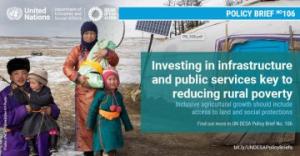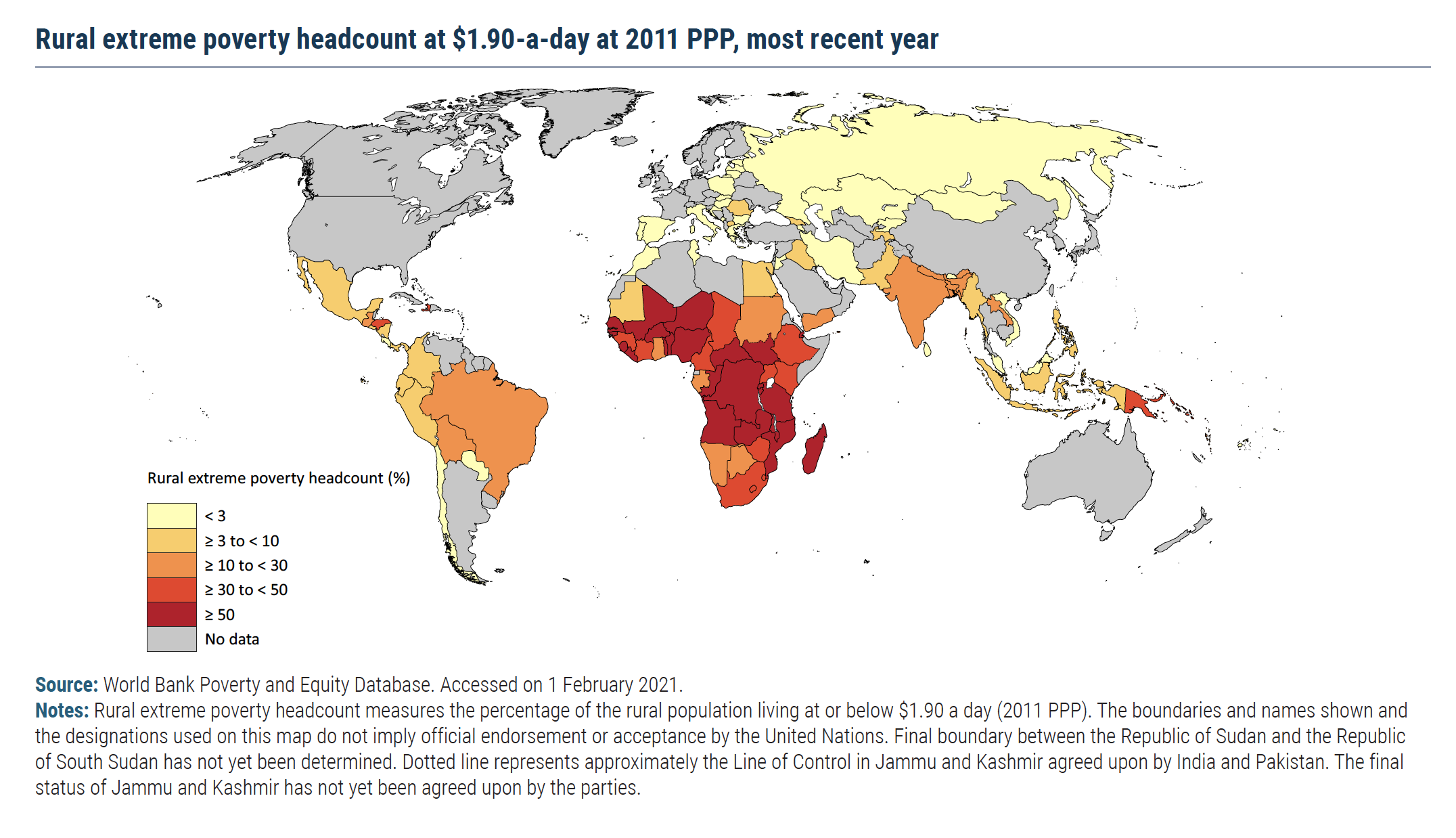 Introduction
Introduction
Extreme poverty is mainly a rural phenomenon. Four of every five people below the $1.90-a-day international income poverty line lived in rural areas in 2013 (Castañeda and others, 2018). Over the last decades, however, there has been tremendous progress in reducing rural poverty, partly as a result of successful policies promoting economic opportunities for the rural poor and expanding social protection in rural areas.
This progress has not been equitable across the board. The same economic forces that reduce poverty, including rural development and urbanization, can increase inequalities. Moreover, poverty is now rising due to the COVID-19 crisis. All evidence points to increasing inequality as well. The pandemic and subsequent lockdown measures have affected urban areas disproportionately but have had a substantial impact on rural residents. Travel and transport restrictions disrupt the livelihoods of the rural poor, many of whom depend on mobility, seasonal and migrant work and remittances. In some countries, there has been a massive return of migrants to rural areas, largely due to job loss.
This policy brief focuses on the linkages between poverty and inequality in rural areas. It illustrates that rural poverty and rural inequalities, although interlinked, follow different dynamics. The brief concludes by discussing policies that promote inclusive development in rural areas.
Rural development and poverty reduction
Poverty remains mainly a rural challenge: 80 per cent of people in poverty live in rural areas; many developing countries present a large size of rural population; 18 per cent of rural residents lived in extreme poverty in 2013, compared to around 5 per cent of urban residents (Castañeda and others, 2018). Much like national poverty rates, rural poverty rates are the highest in sub-Saharan Africa, where more than 50 per cent of the rural population live in extreme poverty in numerous countries (see map).
The situation of the rural poor is made worse by inadequate access to public services, infrastructure and social protection. The COVID-19 pandemic has compounded their already vulnerable position by reducing incomes, limiting mobility and undermining food security. Despite persistent rural disadvantage, poverty is declining faster in rural than in urban areas. A study of 19 countries with data shows that the rate of rural poverty reduction has been higher than that of urban poverty reduction in all countries but one. However, reaching the very poorest remains challenging. Over the past 30 years, developing countries have made little progress in raising the level of consumption of the poorest – they have been left behind (Ravallion, 2016a).
Rural development and inequalities
While the rate of poverty is higher in rural than in urban areas, income inequality is often lower in the former, since top incomes are mostly earned in cities. This is the case in 44 of the 56 countries for which rural and urban income inequality estimates (based on the Gini coefficient) are available. Despite differences in inequality levels, trends are qualitatively similar in urban and rural areas. The fact that inequality tends to move in the same direction in both rural and urban areas – at least in countries with data – is not surprising. At the national level, rural and urban areas share common institutions and development patterns. Rural development is thus affected by national and regional contexts, particularly linkages between urban and rural areas.
Aside from income inequality, there has been some reduction in rural-urban gaps in access to basic services and opportunities. On average, progress in secondary school attendance, the reduction of stunting and access to electricity has been somewhat faster in rural than in urban areas since the 1990s (United Nations, 2020). Nevertheless, even if the progress observed in these dimensions of well-being continues at the same pace, it will take more than four decades to close rural-urban gaps in these dimensions of opportunity (ibid.). That is, under a business- as-usual scenario, rural areas will still lag far behind urban areas by 2030.
Within rural areas, inequalities in basic markers of opportunity – such as child health and school attendance – remain high and are persistent for specific groups. As shown in the United Nations World Social Reports 2020 and 2021, wealthier rural households with a well-educated head are almost as well off as the average urban household, while rural households in the bottom wealth quintiles with an uneducated head are far worse off. For indigenous peoples and ethnic minority groups, the available evidence suggests that wealth and opportunity gaps between them and the ethnic majority are greater in rural than in urban areas. The overlay of gender with rural residence confers additional disadvantages to rural women, who face more obstacles to accessing education than rural men or women in urban areas and have lower levels of ownership and control of assets (including land), less access to paid employment and lower access to public services.
Reducing poverty and inequality in rural areas as complementary goals
Reductions in rural poverty have not always led to reductions in rural inequalities or in inequalities between rural and urban areas. The available data indicate that efforts to reduce rural poverty in the past did not always occur in tandem with efforts to reduce inequality. In China, India and Indonesia, for example, rural inequality increased or remained constant while rural poverty fell significantly between the 2000s and the 2010s.
Regional and time trends suggest that declines in inequality are not a systematic outcome of growth and development. The same economic forces that drive falling poverty can cause a rise in inequality within rural areas and between urban and rural areas. Agricultural development, a key driver of rural poverty reduction, can exacerbate rural inequality if those who are better off reap greater benefits from agricultural growth. Differences in the ability to take advantage of growth can arise from disparities among population groups in their access to resources such as land, education and labour markets. Inequality trends may also vary depending on the sector and nature of economic growth. Urbanization and diversification away from agriculture in developing countries, for instance, can concentrate economic returns in urban areas and wealthier households.
Persistent and growing inequality can be detrimental to growth and poverty reduction. In rural areas with high inequality, people in poverty – who are already disadvantaged in access to resources – benefit less from subsequent growth, or even from periods of agricultural expansion. Left unaddressed, challenges faced by the rural poor in trying to escape poverty and fulfil their potential ultimately lead to constraints on rural economic growth.
Inequalities and rural areas: which policies matter?
Most rural development strategies are designed to promote growth and reduce rural poverty. Few aim explicitly at reducing inequality (Ravallion, 2016b). Yet more equitable and inclusive rural development does not occur naturally or in isolation of wider national trends. It requires promoting access to quality education, health and other services as well as opportunities for decent work, especially for the rural poor. It also calls for building resilience to shocks, addressing the degradation of natural resources and reducing inequality of opportunity both within rural areas and between rural and urban areas. Inclusive rural development therefore requires both localized rural policies and action at the national level. The right mix of economic and social policies, both rural and national, can spur economic development while reducing poverty and inequality in rural areas. There are five broad policy lessons from countries that have succeeded in reducing both rural poverty and rural inequality.
• Invest in infrastructure and public services. Sustained investments in roads, electrification, improved sanitation, safe drinking water, education, health care and the bridging of the digital divide in rural areas will be required to eradicate extreme poverty and to close rural-urban disparities. Such investments must also address inequalities in access to public infrastructure and services within rural areas to ensure that no area or group of people are left behind.
• Promote inclusive agricultural development. Agricultural growth is estimated to be two to three times as effective in reducing poverty as growth in other sectors and benefits mainly the poorest in society (Christiaensen and Martin, 2018). The benefits of promoting inclusive agricultural development are both direct, through increased incomes and food security, and indirect, through increased investment in health and education.
• Ensure a fair distribution of and secure access to land and its natural resources. As populations and economies grow, and climate change affects natural resources, constraints on available land and natural resources may arise. Policy choices will influence whether this increased competition for resources leads to innovation and inclusive development or to degradation, scarcity and inequalities of access and control over these resources. A fair distribution is essential, regardless of whether tenure is based on individual or collective rights. Moreover, it is vital to ensure rural women’s equal access to land and natural resources and address discriminatory laws and practices that impede their rights in this regard.
• Improve social protection coverage in rural areas. Social protection coverage in rural areas is generally lower than in urban areas. Few social protection programmes are explicitly tailored to rural populations or take into account their specific circumstances. There are legal, administrative and financial barriers that must be addressed in order to increase coverage of social protection in rural areas (ILO and FAO, 2021). To overcome these structural barriers, legal frameworks can be adjusted – such as through modifying contributory schemes – to account for informal employment and other forms of employment common in rural areas; participation in contributory schemes can be improved through subsidies; and the hidden costs of participation in all forms of social protection can be lowered, for example by offering one-stop shop solutions, utilizing digital platforms and reducing administrative red tape.
• End all forms of discrimination. Discrimination remains a persistent driver of inequality. Because of the systematic exclusion of ethnic minorities, indigenous peoples, women and other groups, the benefits of rural growth are likely to be unevenly distributed, unless swift action is taken to promote their inclusion, including by addressing prejudice and discrimination.
 Welcome to the United Nations
Welcome to the United Nations

